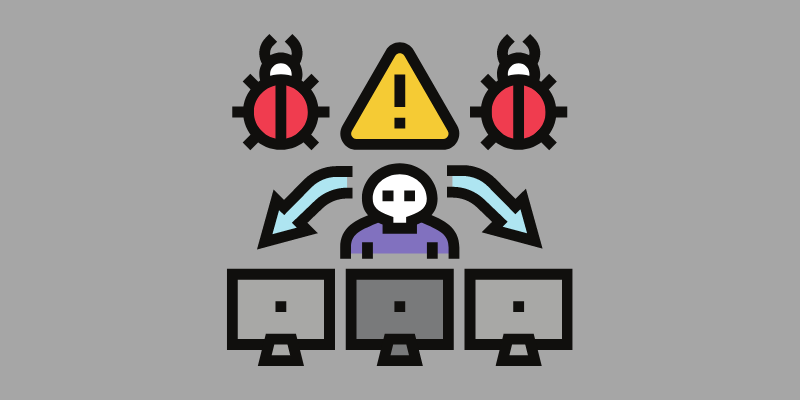Hackers and cybercriminals are becoming more sophisticated these days, making it imperative that organizations stay ahead of malicious means and ensure the utmost security.
The primary goal of cybercriminals is to acquire data, like sensitive customer and business information, for malicious purposes. Hackers use several types of attacks, like malware, phishing, and DDoS, to access the company’s network and compromise its data.
And they do this through attack vectors, which include stolen credentials, viruses, ransomware, and more.
These cyberattacks cost organizations hundreds of millions. For example, the 2022 data breach cost report suggests that the average global data breach cost is around $4.35 million, making it essential for organizations to plan and reduce the potential of these attack vectors.
In this blog, we’ll see exactly what attack vectors mean, the examples and types of attack vectors, how they differ from an attack surface, and what measures you can take to minimize the risks and potentials of attack vectors to keep your organization’s network safe and secure.
What is an Attack Vector in Cybersecurity?
Attack vectors, also referred to as threat vectors, are the means or pathways cyber attackers use to gain illegal access and penetrate through the network, application, or user account to exploit network vulnerabilities.
In simple terms, an attack vector is a route cybercriminals take to reach a target (like an organization’s network) to conduct a cyberattack.
These routes and means can include weak employee credentials, malware, insider threats, etc.
Several entities are responsible for exploiting these attack vectors, including malicious hackers, competitors, cyber espionage groups, and even frustrated or upset former employees.
Irrespective of the entity or group of individuals, they use the attack vectors to steal your company’s confidential information, extort money from your employees, or disrupt your business entirely.
Hence, reducing the amount and impact of attack vectors on your company’s network is highly critical, and you can do this by reducing the attack surface.
Often, individuals confuse attack vectors and surfaces with being the same but differ distinctly. Let’s see how.
Attack Vector vs. Attack Surface
While the two teams are often used interchangeably, they aren’t the same.
An attack vector provides hackers with means or a point of entry to the target or the company network. An attack surface is the area of a system or an organization’s network that’s been attacked or is susceptible to hacking.
It makes up all the points of access, security risks, and entry points that expose your network and that an unauthorized entity can use to enter your network or system.
Employees and their devices are part of an organization’s attack surface as hackers can compromise their credentials and vulnerabilities, like unpatched software, to exploit the network. Hence, an attack surface consists of all the known and unknown vulnerabilities across the systems, network, and hardware components.
The smaller your organization network’s attack surface, the easier it is to protect the network.
Hence, the first and foremost step towards ensuring cybersecurity for your organization should be to minimize the network’s attack surface with the help of advanced security solutions, like Zero Trust Security and Multi-Factor Authentication.
How Do Attack Vectors Work?
Attack vectors work by exploiting vulnerabilities and weaknesses in a system’s defenses.
Generally, hackers and cybercriminals have in-depth knowledge of the common attack vectors present within the network. Therefore, to determine a way to target one of these security vectors, hackers first seek out security holes with these attack vectors to compromise and penetrate through them.

Hackers can find these vulnerabilities in an Operating System (OS) or computer software. A security loophole can open up for several reasons, like a faulty or misconfigured security configuration or a programming error. At the same time, a security breach can also happen due to stolen employee credentials.
Hackers constantly scan companies’ networks to find security loopholes and entry points into systems, networks, and applications. In some cases, hackers can also target internal employees and vulnerable users who knowingly or unknowingly share their account or IT credentials, enabling unauthorized network access.
Attack vectors can be split into two primary types:
#1. Passive Attack Vectors
These attack vector exploits are attempts by hackers to gain access to the system or monitor it for open ports and vulnerabilities to gather details about the target. These attacks try to access the information without affecting the system or altering its data and resources, making them difficult to detect and identify.
Thus, instead of damaging the organization’s network or system, these attacks threaten its data and confidentiality. Examples of passive attacks include phishing, typosquatting, and social engineering-based attacks.
#2. Active Attack Vectors
The active attack vector exploits attempt to alter an organization’s system and disrupt its regular operation.
Thus, the attackers target and exploit the system’s vulnerabilities, such as malware, ransomware, DDoS attacks, man-in-the-middle attacks, or targeting weak user passwords and credentials.
However, while these generalize the attack vector types, here are the similarities in how most of the attack vectors work:
- The attacker detects a potential target.
- The attacker collects information about the target with the help of phishing, social engineering, malware, automated vulnerability scanning, and OPSEC.
- Attackers try to identify potential attack vectors using this information to create tools to exploit them.
- Using these tools, attackers gain unauthorized and unauthenticated access to the system or the network to install malicious code or steal sensitive information.
- Attackers monitor the network, steal confidential data and information, or utilize computing resources.
We can better understand attack vectors and how they work by looking at the types of attack vectors.
What are the Types of Attack Vectors?
Network-Based Attack Vectors
The network-based attacks are controlled and launched from a malicious device other than the one in the attack. They include DDoS attacks, password-based attacks like weak credentials, DNS spoofing, session hijacking, and man-in-the-middle attacks.
#1. Denial of Distributed Services (DDoS) attacks

DDoS attacks are cyberattacks where the attacker floods or overloads a network or server with internet traffic using loads of bots, attempting to disrupt the service to make it inoperable. This makes it difficult for users and customers to access a business’s services and can also make websites crash and go down.
How to Avoid Them: Reducing the organization’s attack surface area is an ideal way to mitigate DDoS attacks. You can do this by restricting direct access to systems and applications and controlling access through Identity and access management (IAM) systems. Using firewalls to filter and avoid malicious traffic and defense tools like traffic differentiation and regular risk assessment is another way to prevent DDoS attacks.
#2. Weak Credentials

Password reuse or weak passwords and credentials are gateways for hackers and attackers to access and penetrate a network.
How to Avoid Them: Organizations need to educate their employees about secure passwords and credentials, invest in a single sign-on or a password manager, and track password hygiene across the entire enterprise network to find and detect high-risk users and their devices.
#3. DNS Spoofing

DNS spoofing, or DNS poisoning, is a cyberattack where the attacker targets and corrupts the Domain Name System (DNS) to point the domain name to an incorrect IP address, redirecting users to malicious servers or websites whenever they try to access a website.
How to Avoid Them: You must set up DNS Security Extensions (DNSSE) to protect your server registrar from external tampering. You can also prevent DNS spoofing by using automated patch management software to apply patches to DNS Servers regularly and performing thorough DNS traffic filtering.
#4. Man-In-The-Middle Attacks

This attack exploits the public Wi-Fi to intercept traffic, eavesdrop, or tamper communication between entities.
How to Avoid Them: You can prevent MITM attacks by leveraging an endpoint security system, employing a Multi-Factor Authentication system, and using robust network security solutions like Zero Trust Security, securing your enterprise network from malicious actors.
Web-Based Attack Vectors
The web-based attacks include cross-site scripting (XSS) and SQL injection attacks. They delude the users using web systems and services as the threat vector.
#1. SQL Injection Attacks

SQL injections use malicious SQL queries to expose the server to confidential and sensitive data and information it otherwise wouldn’t. Successful SQL injection attacks can make hackers change data, spoof identity, or destroy the data, making it unavailable.
How to Avoid Them: You can prevent SQL injections using third-party authentication, password hashing, web application firewall, using updated software and ensuring regular software patching, and continuously monitoring SQL statements and databases.
#2. Cross-Site Scripting (XSS)
XSS attacks involve the attacker injecting malicious code into a trusted website, impacting visitors and not attacking the website itself. This allows hackers to access the browser’s stored records due to the execution of unwanted code and expose unwanted information.
How to Avoid Them: The best way to prevent XSS attacks is by encoding and sanitizing the user input, keeping software up-to-date, scanning for vulnerabilities, and implementing a content security policy.
Physical Attack Vectors
Physical attacks are cybersecurity attacks that impact the website’s operations and physical environment or damage property. They include zero-day attacks or unpatched applications or software, weak encryption, misconfiguration, data injections, brute force attacks, etc.
#1. Zero-Day Attacks (Unpatched Applications)
Zero-day attacks target cybersecurity vulnerability that hasn’t been publicly disclosed or that no one is looking for.
How to Avoid Them: You can prevent zero-day attacks using threat intelligence platforms, threat prevention engines, DNA malware analysis, threat emulation and extraction, and CPU Level inspection.
#2. Weak Encryption

Data encryption protects the confidentiality of digital data and hides the message’s true meaning. Common data encryption methods include DNSSEC and SSL Certificates. Missing or weak encryption exposes the data to unauthorized and malicious parties.
How to Avoid Them: You can secure the weak encryption threat vector by using strong encryption methods, like Rivest-Shamir-Adleman (RSA) and Advanced Encryption Standard (AES), and ensure all the protocols are secure.
#3. Misconfiguration
An error in the system configuration, or if the application’s or setup server’s configuration isn’t disabled, can lead to data breaches. At the same time, using the default username and passwords also makes it easier for hackers to access and exploit the system and determine the hidden flaws.
How to Avoid Them: It’s critical to automate configuration management to prevent configuration drift, monitor the application’s settings, and compare them with best practices—revealing threats for misconfigured devices.
#4. Brute Force Attacks
Brute force attacks are trial-and-error-based cyberattacks where attacks try to access the organization’s networks through various means, like targeting weak encryption, sending infected emails containing malware, or phishing emails until one attack works.
How to Avoid Them: You must use strong passwords, employ MFA solutions, limit login attempts, use Web Application Firewall, use CAPTCHA, and monitor IP addresses to prevent brute force attacks.
Malware Attacks

Malicious software or malware is designed to disrupt systems, slow down computers, cause errors, or spread viruses within the systems. They include several attacks, including spyware, ransomware, viruses, and trojans.
How to Avoid Them: Security against malware requires companies to employ technologies like firewalls, sandboxing, anti-malware, and anti-virus software.
Phishing Attacks
Phishing is a commonly used attack vector that grew by 61% in 2022.
It relies on social engineering tactics to manipulate users into clicking on malicious URLs, downloading malicious files, or revealing sensitive information to steal financial details, obtain credentials, or launch ransomware attacks.
How to avoid them: Deploying MFA, using spam filters, ensuring regular software updates and patching, and blocking malicious websites are a few ways to protect your company from phishing attacks.
Insider Threats

Malicious insiders, like unhappy employees, are amongst the biggest security threats—trying to access the company’s sensitive data to misuse it or offer unauthorized access to external parties.
How to Avoid Them: Monitoring network access by employees for unusual activities or them trying to access files they normally wouldn’t is a sign of abnormal user activity and can help you prevent an insider risk.
How to Protect Your Organization From Attack Vectors?
Attackers can infiltrate the company’s network and compromise its data through several means. Hence, organizations must implement the latest security techniques and robust policies to ensure network security against malicious attacks.
Here are some ways organizations can protect their network from attack vectors:
- Use strong passwords and implement strong authentication solutions, like MFA, to add an extra security layer.
- Conduct regular audits and IT vulnerability testing to detect loopholes and update security policies.
- Install security monitoring and reporting tools that alert you about unauthorized access.
- Perform penetration tests to identify and test security vulnerabilities.
- Install software and hardware updates immediately and employ an automated solution.
- Use encryption technologies, like AES, to enable data encryption on portable devices and reduce risks of data compromise.
- Provide comprehensive IT security training to all your employees—making them aware of the best security practices.
- Use robust access control protocols and segment your network—making it difficult for hackers to get into the core of your company network.
Final Words
Attackers exploit attack vectors, like employee credentials and poor encryption, to compromise a company’s network and breach its data. Hence, reducing the impact of these vectors is highly significant in preventing cybersecurity risks.
The human element (which includes errors, misuse, and social attacks) that plays a massive role in stolen credentials and phishing attacks is a common threat vector—the root cause of about 82% of data breaches in 2022.
Thus, this blog helps you understand attack vectors and ways to minimize their impact. So, use this blog to implement the best security practices to secure your business’s future and prevent financial loss.
Next, check out the top network vulnerabilities to watch out for.



















